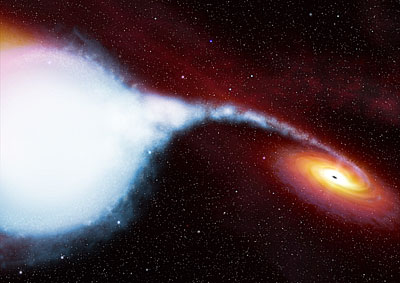







| BOOKS | F. A. Q. | ARTICLES | TALKS | ABOUT KEN | DONATE | BEYOND OUR KEN |
|---|
By Ken Croswell
Published on ScienceNOW (August 8, 2011)

Surf's not up. Don't expect to detect any gravitational waves from Cygnus X-1. Credit: ESA. Illustration by Martin Kornmesser, ESA/ECF.
The Canadian rock band Rush knows its astronomy. In a lengthy 1977 song, the musicians proclaimed Cygnus X-1, an x-ray emitting object thousands of light-years away, a black hole where voyagers venture "through the void to be destroyed"--even though physicist Stephen Hawking had bet against the black hole's existence. This year, astronomers proved Rush right by establishing that Cygnus X-1 does indeed harbor a black hole, a dead star whose great gravity lets nothing, not even light, escape. Now that result has inspired a forecast for the system's future: the black hole will swallow even more mass from an unfortunate star circling it, then likely dash away on its own when its companion explodes.
Cygnus X-1 bears its name because it was the first source of x-rays found in the constellation Cygnus. In 1971, astronomers discovered that the x-rays came from the direction of a bright blue star whirling around a mysterious dark object. Scientists speculated that the x-rays were resulting from material being torn away from the bright star and falling onto the dark object, perhaps a black hole.
Earlier this year, astronomers measured the first precise distance to Cygnus X-1, finding it to be about 6,000 light-years from Earth. This distance then yielded the mass of the bright star as well as the dark object; the latter is so massive it can only be a black hole.
Now astronomers Krzysztof Belczynski and Tomasz Bulik of the University of Warsaw and Charles Bailyn of Yale University have used the precise new parameters for Cygnus X-1 to predict its fate. "We took the system and moved it forward in time," Belczynski says. In work submitted to The Astrophysical Journal Letters, his team calculates that the black hole, now weighing 14.8 suns, will gobble an additional three suns' worth of material from its companion. And the companion, whose mass is now 19.2 suns, will slim down to just four solar masses by losing material both to its ravenous partner and to the Galaxy at large.
As the bright star transfers mass to the black hole, the two will slowly move away from each other because their orbits will readjust to the change in mass. Today, their centers are about half as far apart as Mercury is from the Sun, but Belczynski's team says this distance will grow until it's slightly greater than that between the Sun and Earth. "That's a key issue," Belczynski says, because when the star explodes, about 2.6 million years from now, it will be so far from the black hole that there's about a 70 percent chance it will shoot away from the black hole, leaving its dark companion to sail through the Galaxy alone.
By then, the star will have become a neutron star, a dead star less extreme than a black hole. Even if the black hole and neutron star remain in orbit, they will probably stay far apart. As a result, they won't merge into one--an event that would trigger gravitational waves, ripples in spacetime predicted by Albert Einstein's general theory of relativity that observers are currently hoping to detect. Thus, Belczynski's team concludes that if Cygnus X-1 is representative of future black hole-neutron star binaries, observers seeking to detect gravitational waves should not expect to see them from mergers of such systems. In fact, no black hole-neutron star binaries are yet known.
Astronomer Vicky Kalogera of Northwestern University in Evanston, Illinois, who recently modeled the past of Cygnus X-1, says the forecast for its future makes sense. But she has reservations about the conclusion concerning gravitational waves. "When using a single system, there's a lot of uncertainty," she says. "It's not clear that this one system represents everything that can eventually form black hole-neutron star binaries in the Galaxy." Belczynski agrees, saying that if mergers of black hole-neutron star binaries prove to be common, they must arise from systems that don't resemble Cygnus X-1.
Perhaps something for Rush to ponder on its next album.
Ken Croswell is an astronomer and the author of The Lives of Stars.
"A stellar picture of what we know or guess about those distant lights."--Kirkus. See all reviews of The Lives of Stars here.
| BOOKS | F. A. Q. | ARTICLES | TALKS | ABOUT KEN | DONATE | BEYOND OUR KEN |
|---|